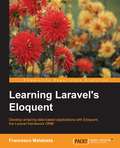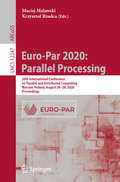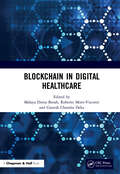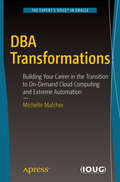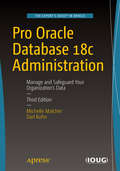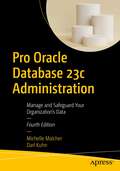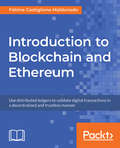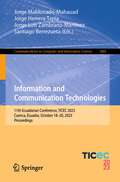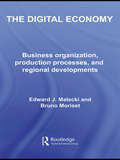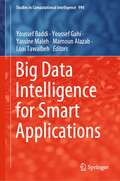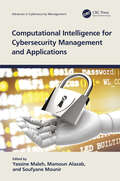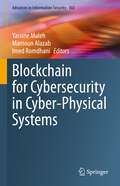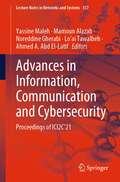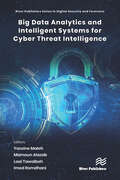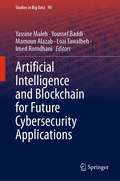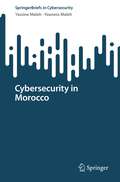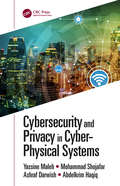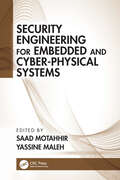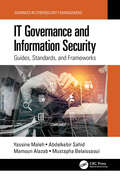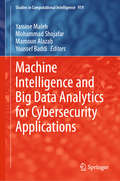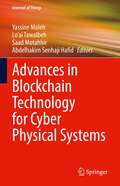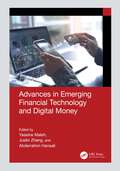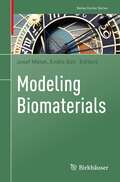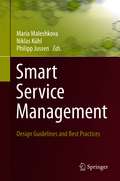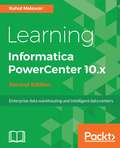- Table View
- List View
Learning Laravel's Eloquent
by Francesco MalatestaThis book is perfect for developers with some basic knowledge of PHP development, but are new to the Eloquent ORM. However, developers with previous Laravel and Eloquent experience will also benefit from the in-depth analysis of specific classes and methodologies in the book.
Euro-Par 2020: 26th International Conference on Parallel and Distributed Computing, Warsaw, Poland, August 24–28, 2020, Proceedings (Lecture Notes in Computer Science #12247)
by Maciej Malawski Krzysztof RzadcaThis book constitutes the proceedings of the 26th International Conference on Parallel and Distributed Computing, Euro-Par 2020, held in Warsaw, Poland, in August 2020. The conference was held virtually due to the coronavirus pandemic. The 39 full papers presented in this volume were carefully reviewed and selected from 158 submissions. They deal with parallel and distributed computing in general, focusing on support tools and environments; performance and power modeling, prediction and evaluation; scheduling and load balancing; high performance architectures and compilers; data management, analytics and machine learning; cluster, cloud and edge computing; theory and algorithms for parallel and distributed processing; parallel and distributed programming, interfaces, and languages; multicore and manycore parallelism; parallel numerical methods and applications; and accelerator computing.
Blockchain in Digital Healthcare
by Malaya Dutta Borah, Roberto Moro-Visconti and Ganesh Chandra DekaBlockchain is a series of transactions recorded in blocks and secured cryptographically. It is immutable, decentralized, and transparent and has proved to be beneficial across all domains to protect and store data. Maintaining privacy, integrity, and security, blockchain is particularly valuable to the healthcare industry. of healthcare data. Blockchain in Digital Healthcare provides a panoramic review of prospects of blockchain technology in the healthcare domain. Users can record transactions in blocks in an immutable distributed ledger that cannot be changed once recorded and/or published. Blockchain is also decentralized, which eliminates dependency on a trusted third party to facilitate transactions, enabling clients and other users of the blockchain to take ownership of the data they push on the network. Blockchain also makes transactions more secure as clients have their own copies. Features: Provides systematic and comprehensive understanding of the block chain technology and the potential in healthcare Describes how security and privacy concerns of healthcare data can be addressed using Blockchain Technology Discusses the concept of smart contracts for performing advanced level scripting to create a blockchain network to provide a platform for the development of decentralized applications Includes a chapter on role of blockchain based insurance application using Ethereum/Hyperledger Presents cases of blockchain use for various aspects of drug manufacturing and the pharma supply chain This book serves as a reference book for IT professionals, scientific investigators and researchers who need to analyze the prospects of blockchain technology in healthcare.
DBA Transformations: Building Your Career in the Transition to On-Demand Cloud Computing and Extreme Automation
by Michelle MalcherAdapt your career as a database administrator to the changing industry. Learn where the growth and demand for DBA talent are occurring and how to enhance your skill set. Creating databases, providing access, and controlling data are no longer the focus. What matters now is managing and monitoring the systems that provide access to users of the data. This book will help you formulate a plan for development and change to remain valuable in the face of radical new developments around cloud computing, containerized databases, and automation of routine tasks. The playing field is shifting rapidly with the development of technologies and software enhancements that automate and even eliminate many traditional aspects of the DBA job. DBA Transformation helps you redirect your attention and skills as a DBA to areas such as design and development of the containers and cloud environments on which automation depends. You will be encouraged to build soft skills as well as to focus on technical pain points such as data security that are of even greater importance now that so much corporate data is in cloud-based systems that are accessible from the Internet at large. What You'll Learn Embrace and profit from rapid shifts in the database industry Recognize where growth and demand for talent are occurring Create a personal transformation plan to help you navigate the changes Pivot your career toward more interesting skills and responsibilities Who This Books Is For Working database professionals who are interested in keeping their careers relevant as well as building their careers and making them stronger in the face of dramatic changes that are being driven by trends toward cloud computing and containerization
Pro Oracle Database 18c Administration: Manage and Safeguard Your Organization’s Data
by Michelle Malcher Darl KuhnDatabase administration isn’t about passing a certified exam, or about pointing and clicking your way through a crisis. Database administration is about applying the right solution at the right time, avoiding risk, and making robust choices that get you home each night in time for dinner with your family. This book will help elevate you to the level of Professional Oracle Database Administrator.This book provides information and techniques for keeping an Oracle database stable and running on-premise, and is fully updated to cover Oracle Database 18c. New in this edition is coverage of cloud administration in the Oracle Public Cloud, automation of tasks using the autonomous database features, and data movement with multi-tenant databases. The book covers everything from architecture of the database engine, securing objects and users, strategies for performing maintenance tasks and resolving performance problems, through to backup and recovery. Pro Oracle Database 18c Administration takes a modern approach to database administration. Emphasis is given to automation, which is of growing importance as more databases are being moved into various cloud solutions and database administrators are being required to manage more instances than ever. Focus is given to multi-tenant container architecture and pluggable databases, and the book takes a refreshing, results-oriented approach that helps you get the job done. What You'll LearnUnderstand the differences between managing on-premise and cloud deploymentsTake advantage of new features in 18c while also managing older releasesManage more databases than ever by automating your environmentApply the latest techniques around pluggable databases and containerizationSafeguard your data through good security and backup/recovery practicesTroubleshoot common problemsWho This Book Is ForDatabase architects and administrators who want to level-up to the latest techniques around containerization, automation, and cloud deployment. The book also is appropriate for Oracle professionals desiring to present themselves as being competitive and up-to-date with the latest in the field.
Pro Oracle Database 23c Administration: Manage and Safeguard Your Organization’s Data
by Michelle Malcher Darl KuhnMaster Oracle Database administration in both on-premises and cloud environments. This new edition covers the tasks you’ll need to perform to keep your databases stable, tuned, and running. The book also includes administrative tasks specific to cloud environments, including the Oracle Autonomous Database running in the Oracle Cloud Infrastructure. New in this edition is help for DBAs who are becoming involved in data management, and a look at the idea of a converged database and what that means in handling various data types and workloads. The book covers some of the machine learning features now in Oracle and shows how the same SQL that you know for database administration also helps you with data management tasks. The information in this book helps you to apply the right solution at the right time, mitigating risk and making robust choices that protect your data and avoid midnight phone calls.Data management is increasingly a DBA function, and DBAs are often called upon for help in getting data loaded into analytics environments such as a data lakehouse or a data mesh. This book addresses this fast-growing new role for database administrators and helps you build on your existing knowledge to make the transition into a new skill set that is in high demand. You’ll learn how to look at data optimization from the standpoint of data analysis and machine learning so that you can be seen as a key player in preparing your organization’s data for those type of activities. You’ll know how to pull back information from a combination of relational tables and JSON structures. You’ll become familiar with the tools that Oracle Database provides to make analytics easier and more straightforward. And you’ll learn simpler ways to manage time-based tables that eliminate the need for painfully creating triggers to track the history of row changes over time.This book builds your skills as an Oracle Database administrator with the aim of helping you to be seen as a key player in data management as your organization pivots toward cloud computing and a greater use of machine learning and analytics technologies.What You'll LearnConfigure and manage Oracle 23c databases both on-premises and in the cloudMeet your DBA responsibilities in the Oracle Cloud and with Database Cloud ServicesPerform administrative tasks for Autonomous Database dedicated environmentsPerform DBA tasks and effectively use data management tools Migrate from on-premises to the Oracle Cloud InfrastructureTroubleshoot issues with Oracle 23c databases and quickly solve performance problemsArchitect cloud, on-premises, hybrid, and multi-cloud database environments Who This Book Is ForOracle database administrators (DBAs) who want to be current with the new features in Oracle Database 23c. For any DBA who is tasked with managing Oracle databases in cloud, hybrid cloud, and multi-cloud configurations. Also helpful for data architects who are designing analytic solutions in data lakehouse and data mesh environments.
Introduction to Blockchain and Ethereum: Use distributed ledgers to validate digital transactions in a decentralized and trustless manner
by Fatima Castiglione MaldonadoBuild distributed applications that resolve data ownership issues when working with transactions between multiple partiesKey FeaturesExplore a perfect balance between theories and hands-on activitiesDiscover popular Blockchain use cases such as BitcoinCreate your first smart contract in Solidity for EthereumBook DescriptionBlockchain applications provide a single-shared ledger to eliminate trust issues involving multiple stakeholders. With the help of Introduction to Blockchain and Ethereum, you'll learn how to create distributed Blockchain applications which do not depend on a central server or datacenter. The course begins by explaining Bitcoin, Altcoins, and Ethereum, followed by taking you through distributed programming using the Solidity language on the Ethereum Blockchain. By the end of this course, you'll be able to write, compile, and deploy your own smart contracts to the Ethereum Blockchain.What you will learnGrasp Blockchain concepts such as private and public keys, addresses, wallets, and hashesSend and analyze transactions in the Ethereum Rinkeby test networkCompile and deploy your own ERC20-compliant smart contracts and tokensTest your smart contracts using MyEtherWalletCreate a distributed web interface for your contractCombine Solidity and JavaScript to create your very own decentralized applicationWho this book is forIntroduction to Blockchain and Ethereum is ideal for you if you want to get to grips with Blockchain technology and develop your own distributed applications with smart contracts written in Solidity. Prior exposure to an object-oriented programming language such as JavaScript is needed, as you'll cover the basics before getting straight to work.
Information and Communication Technologies: 11th Ecuadorian Conference, TICEC 2023, Cuenca, Ecuador, October 18–20, 2023, Proceedings (Communications in Computer and Information Science #1885)
by Jorge Maldonado-Mahauad Jorge Herrera-Tapia Jorge Luis Zambrano-Martínez Santiago BerrezuetaThis book constitutes the proceedings of the 11th Ecuadorian Conference on Information and Communication Technologies, TICEC 2023, held in Cuenca, Ecuador, during October 18–20, 2023.The 31 full papers presented were carefully reviewed and selected from 120 submissions. The papers cover a great variety of topics, such as internet of things, cyber-physical systems, human-machine interface, artificial Intelligence, e-Learning, smart healthcare, smart healthcare and others. The papers are organized in the following topical sections: data science and machine learning; ICTs and their applications; and software development.
The Digital Economy: Business Organization, Production Processes and Regional Developments
by Edward J. Malecki Bruno MorisetInformation technologies (IT) shape economic space, but we have no clear map of the cyber economy since the "digital revolution" began in the early 1970s. The Digital Economy offers an up-to-date, critical synthesis that links the various aspects of the digital or cyber economy from the perspective of real firms. A geographic approach emphasizes how IT has made businesses less dependent on locational constraints, and the tangible effects on places and regions are placed at the core of the analysis. Case studies of companies, including Amazon, Dell, Li & Fung, and Volvo, demonstrate that the geography of digitally-driven production is the outcome of both dispersion and agglomeration dynamics. Global corporations are shown to have footprints that ignore – to some degree – distance and time, yet creative and coordinating activities remain anchored in urban innovative ecosystems such as Silicon Valley and Bangalore. These trends have been made possible by the development of a worldwide and integrated telecommunications network, whose unequal presence dictates the capabilities of places and communities to be connected to the global economy. However, the threat of the digital divide must not be overstated. In cities, rural areas, and emerging countries, local development is wrapped up in human capital, rather than technology. This engaging and accessible text describes and explains the patterns and dynamics of today’s digital economic space. The effects on places and regions and the people in them are at the core of the authors’ analysis, illustrated by many real examples. This book will be useful to anyone studying business and management, geography and information and communication studies.
Big Data Intelligence for Smart Applications (Studies in Computational Intelligence #994)
by Yassine Maleh Mamoun Alazab Youssef Baddi Loai Tawalbeh Youssef GahiToday, the use of machine intelligence, expert systems, and analytical technologies combined with Big Data is the natural evolution of both disciplines. As a result, there is a pressing need for new and innovative algorithms to help us find effective and practical solutions for smart applications such as smart cities, IoT, healthcare, and cybersecurity.This book presents the latest advances in big data intelligence for smart applications. It explores several problems and their solutions regarding computational intelligence and big data for smart applications. It also discusses new models, practical solutions,and technological advances related to developing and transforming cities through machine intelligence and big data models and techniques. This book is helpful for students and researchers as well as practitioners.
Computational Intelligence for Cybersecurity Management and Applications (Advances in Cybersecurity Management)
by Yassine Maleh Mamoun Alazab Soufyane MounirAs cyberattacks continue to grow in complexity and number, computational intelligence is helping under-resourced security analysts stay one step ahead of threats. Drawing on threat intelligence from millions of studies, blogs, and news articles, computational intelligence techniques such as machine learning and automatic natural language processing quickly provide the means to identify real threats and dramatically reduce response times. Computational Intelligence for Cybersecurity Management and Applications collects and reports on recent high-quality research addressing different cybersecurity challenges. It: Explore the newest developments in the use of computational intelligence and AI for cybersecurity applications; Provide several case studies related to computational intelligence techniques for cybersecurity in a wide range of applications (Smart Healthcare, Blockchain, Cyber-Physical System, etc.); Integrate theoretical and practical aspects of computational intelligence for cybersecurity so that any reader, from novice to expert, may understand the book's explanations of key topics. The book offers comprehensive coverage of the essential topics, including: Machine Learning and Deep Learning for cybersecurity Blockchain for cybersecurity and privacy Security engineering for Cyber-physical systems AI and Data Analytics techniques for cybersecurity in smart systems Trust in digital systems This book discusses the current state of the art and practical solutions for the following cybersecurity and privacy issues using artificial intelligence techniques and cutting-edge technology. Readers interested in learning more about computational intelligence techniques for cybersecurity applications and management will find this book invaluable. They will get insight into potential avenues for future study on these topics and be able to prioritize their efforts better.
Blockchain for Cybersecurity in Cyber-Physical Systems (Advances in Information Security #102)
by Yassine Maleh Mamoun Alazab Imed RomdhaniThis book offers the latest research results on blockchain technology and its application for cybersecurity in cyber-physical systems (CPS). It presents crucial issues in this field and provides a sample of recent advances and insights into the research progress. Practical use of blockchain technology is addressed as well as cybersecurity and cyber threat challenges and issues. This book also offers readers an excellent foundation on the fundamental concepts and principles of blockchain based cybersecurity for cyber-physical systems. It guides the reader through the core ideas with expert ease.Blockchain technology has infiltrated all areas of our lives, from manufacturing to healthcare and beyond. Cybersecurity is an industry that has been significantly affected by this technology, and maybe more so in the future. This book covers various case studies and applications of blockchain in various cyber-physical fields, such as smart cities, IoT, healthcare, manufacturing, online fraud, etc.This book is one of the first reference books covering the application of blockchain technology for cybersecurity in cyber-physical systems (CPS). Researchers working in the cybersecurity field and advanced-level students studying this field will find this book useful as a reference. Decision-makers, managers and professionals also working in this field will want to purchase this book.
Advances in Information, Communication and Cybersecurity: Proceedings of ICI2C’21 (Lecture Notes in Networks and Systems #357)
by Yassine Maleh Mamoun Alazab Lo’ai Tawalbeh Noreddine Gherabi Ahmed A. Abd El-LatifThis book gathers the proceedings of the International Conference on Information, Communication and Cybersecurity, held on November 10–11, 2021, in Khouribga, Morocco. The conference was jointly coorganized by The National School of Applied Sciences of Sultan Moulay Slimane University, Morocco, and Charles Darwin University, Australia. This book provides an opportunity to account for state-of-the-art works, future trends impacting information technology, communications, and cybersecurity, focusing on elucidating the challenges, opportunities, and inter-dependencies that are just around the corner. This book is helpful for students and researchers as well as practitioners.ICI2C 2021 was devoted to advances in smart information technologies, communication, and cybersecurity. It was considered a meeting point for researchers and practitioners to implement advanced information technologies into various industries. There were 159 paper submissions from 24 countries. Each submission was reviewed by at least three chairs or PC members. We accepted 54 regular papers (34\%). Unfortunately, due to limitations of conference topics and edited volumes, the Program Committee was forced to reject some interesting papers, which did not satisfy these topics or publisher requirements. We would like to thank all authors and reviewers for their work and valuable contributions. The friendly and welcoming attitude of conference supporters and contributors made this event a success!
Big Data Analytics and Intelligent Systems for Cyber Threat Intelligence
by Yassine Maleh Mamoun Alazab Loai Tawalbeh Imed RomdhaniIn recent years, a considerable amount of effort has been devoted to cyber-threat protection of computer systems which is one of the most critical cybersecurity tasks for single users and businesses since even a single attack can result in compromised data and sufficient losses. Massive losses and frequent attacks dictate the need for accurate and timely detection methods. Current static and dynamic methods do not provide efficient detection, especially when dealing with zero-day attacks. For this reason, big data analytics and machine intelligencebased techniques can be used. This book brings together researchers in the field of big data analytics and intelligent systems for cyber threat intelligence CTI and key data to advance the mission of anticipating, prohibiting, preventing, preparing, and responding to internal security. The wide variety of topics it presents offers readers multiple perspectives on various disciplines related to big data analytics and intelligent systems for cyber threat intelligence applications. Technical topics discussed in the book include:• Big data analytics for cyber threat intelligence and detection• Artificial intelligence analytics techniques• Real-time situational awareness• Machine learning techniques for CTI• Deep learning techniques for CTI• Malware detection and prevention techniques• Intrusion and cybersecurity threat detection and analysis• Blockchain and machine learning techniques for CTI
Artificial Intelligence and Blockchain for Future Cybersecurity Applications (Studies in Big Data #90)
by Yassine Maleh Youssef Baddi Mamoun Alazab Loai Tawalbeh Imed RomdhaniThis book presents state-of-the-art research on artificial intelligence and blockchain for future cybersecurity applications. The accepted book chapters covered many themes, including artificial intelligence and blockchain challenges, models and applications, cyber threats and intrusions analysis and detection, and many other applications for smart cyber ecosystems. It aspires to provide a relevant reference for students, researchers, engineers, and professionals working in this particular area or those interested in grasping its diverse facets and exploring the latest advances on artificial intelligence and blockchain for future cybersecurity applications.
Cybersecurity in Morocco (SpringerBriefs in Cybersecurity)
by Yassine Maleh Youness MalehThis SpringerBrief contains eight chapters and presents an overview of the evolution of the Moroccan Cybersecurity Strategy. It also draws attention to the development of cybersecurity in Morocco and to ensure national security in the context of the current and developing information confrontation in the international community. However, it cannot promise to provide an in-depth examination. The issue of cybersecurity is simply too wide-ranging for our purposes. This acknowledgment is meant to encourage more detailed research into the broader topics covered in this brief to better inform current approaches to national cybersecurity performance evaluation.This SpringerBrief targets researchers interested in exploring and understanding Morocco and its efforts in implementing its national cybersecurity strategy. This brief is also a relevant reference for diplomats, executives, CISOs, cybersecurity professionals and engineers working in this related field.
Cybersecurity and Privacy in Cyber Physical Systems
by Yassine Maleh Shojafar Mohammad Darwish Ashraf Haqiq AbdelkrimCybersecurity and Privacy in Cyber-Physical Systems collects and reports on recent high-quality research that addresses different problems related to cybersecurity and privacy in cyber-physical systems (CPSs). It Presents high-quality contributions addressing related theoretical and practical aspects Improves the reader’s awareness of cybersecurity and privacy in CPSs Analyzes and presents the state of the art of CPSs, cybersecurity, and related technologies and methodologies Highlights and discusses recent developments and emerging trends in cybersecurity and privacy in CPSs Proposes new models, practical solutions, and technological advances related to cybersecurity and privacy in CPSs Discusses new cybersecurity and privacy models, prototypes, and protocols for CPSs This comprehensive book promotes high-quality research by bringing together researchers and experts in CPS security and privacy from around the world to share their knowledge of the different aspects of CPS security. Cybersecurity and Privacy in Cyber-Physical Systems is ideally suited for policymakers, industrial engineers, researchers, academics, and professionals seeking a thorough understanding of the principles of cybersecurity and privacy in CPSs. They will learn about promising solutions to these research problems and identify unresolved and challenging problems for their own research. Readers will also have an overview of CPS cybersecurity and privacy design.
Security Engineering for Embedded and Cyber-Physical Systems (Advances In Cybersecurity Management Ser.)
by Yassine Maleh Saad MotahhirDigital transformation, also known as Industry 4.0, Smart Industry, and Smart Manufacturing, is at the top of leaders’ agendas. Such a transformation stimulates innovation in new products and services, the digital transformation of processes, and the creation of new business models and ecosystems. In the world of manufacturing, Industry 4.0 is based on various technological advances, among which we can mainly cite CPS (cyber-physical systems), IoT (Internet of Things), and IoS (internet of services). While engaging, this fourth wave also brings significant challenges for manufacturers. Business operations and the supply chain are becoming more vulnerable to cyber threats. Security Engineering for Embedded and Cyber-Physical Systems is an invaluable resource to discover cybersecurity and privacy techniques for embedded and cyber-physical systems. This book presents the latest studies and research results on all aspects of security engineering for embedded and cyber-physical systems. It also provides a premier interdisciplinary reference for researchers, practitioners, and educators to discover the most recent innovations, trends, concerns, and practical challenges encountered and solutions adopted in security engineering for embedded and cyber-physical systems. The book offers comprehensive coverage of the essential topics, including the following: Embedded and cyber-physical systems threats and vulnerabilities Security engineering techniques for embedded and cyber-physical systems Security engineering for embedded and cyber-physical systems and potential future-use cases Artificial intelligence techniques for cybersecurity and privacy Security engineering for Internet of Things Blockchain for cybersecurity in embedded and cyber-physical systems This book comprises a number of state-of-the-art contributions from both scientists and practitioners working in security engineering for embedded and cyber-physical systems. It aspires to provide a relevant reference for students, researchers, engineers, and professionals working in this area or those interested in grasping its diverse facets and exploring the latest advances and future trends related to security engineering for embedded and cyber-physical systems.
IT Governance and Information Security: Guides, Standards, and Frameworks (Advances in Cybersecurity Management)
by Yassine Maleh Abdelkebir Sahid Mamoun Alazab Mustapha BelaissaouiIT governance seems to be one of the best strategies to optimize IT assets in an economic context dominated by information, innovation, and the race for performance. The multiplication of internal and external data and increased digital management, collaboration, and sharing platforms exposes organizations to ever-growing risks. Understanding the threats, assessing the risks, adapting the organization, selecting and implementing the appropriate controls, and implementing a management system are the activities required to establish proactive security governance that will provide management and customers the assurance of an effective mechanism to manage risks. IT Governance and Information Security: Guides, Standards, and Frameworks is a fundamental resource to discover IT governance and information security. This book focuses on the guides, standards, and maturity frameworks for adopting an efficient IT governance and information security strategy in the organization. It describes numerous case studies from an international perspective and brings together industry standards and research from scientific databases. In this way, this book clearly illustrates the issues, problems, and trends related to the topic while promoting the international perspectives of readers. This book offers comprehensive coverage of the essential topics, including: IT governance guides and practices; IT service management as a key pillar for IT governance; Cloud computing as a key pillar for Agile IT governance; Information security governance and maturity frameworks. In this new book, the authors share their experience to help you navigate today’s dangerous information security terrain and take proactive steps to measure your company’s IT governance and information security maturity and prepare your organization to survive, thrive, and keep your data safe. It aspires to provide a relevant reference for executive managers, CISOs, cybersecurity professionals, engineers, and researchers interested in exploring and implementing efficient IT governance and information security strategies.
Machine Intelligence and Big Data Analytics for Cybersecurity Applications (Studies in Computational Intelligence #919)
by Yassine Maleh Mohammad Shojafar Mamoun Alazab Youssef BaddiThis book presents the latest advances in machine intelligence and big data analytics to improve early warning of cyber-attacks, for cybersecurity intrusion detection and monitoring, and malware analysis. Cyber-attacks have posed real and wide-ranging threats for the information society. Detecting cyber-attacks becomes a challenge, not only because of the sophistication of attacks but also because of the large scale and complex nature of today’s IT infrastructures. It discusses novel trends and achievements in machine intelligence and their role in the development of secure systems and identifies open and future research issues related to the application of machine intelligence in the cybersecurity field. Bridging an important gap between machine intelligence, big data, and cybersecurity communities, it aspires to provide a relevant reference for students, researchers, engineers, and professionals working in this area or those interested in grasping its diverse facets and exploring the latest advances on machine intelligence and big data analytics for cybersecurity applications.
Advances in Blockchain Technology for Cyber Physical Systems (Internet of Things)
by Yassine Maleh Lo’ai Tawalbeh Saad Motahhir Abdelhakim Senhaji HafidThe Cyber-Physical System (CPS) relates to many other popularized technologies such as Internet of Things (IoT, IIoT), Machine-to-Machine (M2M), Industry 4.0, which describe a vision of connected creations that deeply unite the physical and information domains. As a revolutionary technology, Blockchain (BC) provides a practical solution to enable a secure and decentralized public ledger that a huge plethora of exciting new technology applications in several areas, such as the Internet of Things (IoT), Cyber-Physical Systems, Manufacturing, Supply-Chain, etc. Blockchain technology has infiltrated all areas of our lives, from manufacturing to healthcare and beyond. In this context, this book helps discover the various potential applications that could be fruitful for cyber-physical system applications. It provides a sampling of recent advances and ideas on research progress and the practical usage of blockchain technologies in addressing cyber-physical systems challenges and issues. It provides a sampling of recent advances and views on research progress and the practical usage of blockchain technologies in addressing cyber-physical systems challenges and issues.
Advances in Emerging Financial Technology and Digital Money
by Yassine Maleh Justin Zhang Abderrahim HansaliThe financial sector is witnessing rapid technological innovations, leading to the emergence of Fintech (financial technologies), revolutionizing national and international financial landscapes. Fintech is expanding and enhancing financial products and services, making them more accessible and affordable while transforming customer relationships, payment methods, financing, and transfers.Advances in Emerging Financial Technology and Digital Money provides a platform for collective reflection, bringing together institutions, policymakers, digital and financial service providers, professionals, and academics from various disciplines. The aim is to clarify the challenges, opportunities, and socio-economic impacts of innovations in finance and technology on citizens and businesses in Morocco, Africa, and worldwide. This comprehensive collection offers valuable insights into the current state and prospects of financial technology and digital money.This book covers all the essential topics, including: AI and Machine Learning in Fintech and Beyond Financial Inclusion, Literacy, and Behavior Fintech Ecosystems, Collaboration, and Analysis Blockchain, Security, and Sustainability Fintech Innovations and Applications In this new book, the authors share their experiences to provide a comprehensive and well‑researched overview of the technologies and concepts that will transform the banking industry as we know it. It aspires to be a useful reference for executive managers, CIOs, Fintech professionals, and researchers interested in exploring and implementing an efficient Fintech strategy. The book also presents selected papers from International Fintech Congress (IFC 2022).
Modeling Biomaterials (Nečas Center Series)
by Josef Málek Endre SüliThe investigation of the role of mechanical and mechano-chemical interactions in cellular processes and tissue development is a rapidly growing research field in the life sciences and in biomedical engineering. Quantitative understanding of this important area in the study of biological systems requires the development of adequate mathematical models for the simulation of the evolution of these systems in space and time. Since expertise in various fields is necessary, this calls for a multidisciplinary approach.This edited volume connects basic physical, biological, and physiological concepts to methods for the mathematical modeling of various materials by pursuing a multiscale approach, from subcellular to organ and system level. Written by active researchers, each chapter provides a detailed introduction to a given field, illustrates various approaches to creating models, and explores recent advances and future research perspectives. Topics covered include molecular dynamics simulations of lipid membranes, phenomenological continuum mechanics of tissue growth, and translational cardiovascular modeling. Modeling Biomaterials will be a valuable resource for both non-specialists and experienced researchers from various domains of science, such as applied mathematics, biophysics, computational physiology, and medicine.
Smart Service Management: Design Guidelines and Best Practices
by Maria Maleshkova Niklas Kühl Philipp JussenThis book presents the main theoretical foundations behind smart services as well as specific guidelines and practically proven methods on how to design them. Furthermore, it gives an overview of the possible implementation architectures and shows how the designed smart services can be realized with specific technologies. Finally, it provides four specific use cases that show how smart services have been realized in practice and what impact they have within the businesses.The first part of the book defines the basic concepts and aims to establish a shared understanding of terms, such as smart services, service systems, smart service systems or cyber-physical systems. On this basis, it provides an analysis of existing work and includes insights on how an organization incorporating smart services could enhance and adjust their management and business processes. The second part on the design of smart services elaborates on what constitutes a successful smart service and describes experiences in the area of interdisciplinary teams, strategic partnerships, the overall service systems and the common data basis. In the third part, technical reference architectures are presented in detail, encompassing topics on the design of digital twins in cyber physical systems, the communication between entities and sensors in the age of Industry 4.0 as well as data management and integration. The fourth part then highlights a number of analytical possibilities that can be realized and that can constitute or be part of smart services, including machine learning and artificial intelligence methods. Finally, the applicability of the introduced design and development method is demonstrated by considering specific real-world use cases. These include services in the industrial and mobility sector, which were developed in direct cooperation with industry partners.The main target audience of this book is industry-focused readers, especially practitioners from industry, who are involved in supporting and managing digital business. These include professionals working in business development, product management, strategy, and development, ranging from middle management to Chief Digital Officers. It conveys all the basics needed for developing smart services and successfully placing them on the market by explaining technical aspects as well as showcasing practical use cases.
Learning Informatica PowerCenter 10.x - Second Edition
by Rahul MalewarHarness the power and simplicity of Informatica PowerCenter 10.x to build and manage efficient data management solutions About This Book • Master PowerCenter 10.x components to create, execute, monitor, and schedule ETL processes with a practical approach. • An ideal guide to building the necessary skills and competencies to become an expert Informatica PowerCenter developer. • A comprehensive guide to fetching/transforming and loading huge volumes of data in a very effective way, with reduced resource consumption Who This Book Is For If you wish to deploy Informatica in enterprise environments and build a career in data warehousing, then this book is for you. Whether you are a software developer/analytic professional and are new to Informatica or an experienced user, you will learn all the features of Informatica 10.x. A basic knowledge of programming and data warehouse concepts is essential. What You Will Learn • Install or upgrade the components of the Informatica PowerCenter tool • Work on various aspects of administrative skills and on the various developer Informatica PowerCenter screens such as Designer, Workflow Manager, Workflow Monitor, and Repository Manager. • Get practical hands-on experience of various sections of Informatica PowerCenter, such as navigator, toolbar, workspace, control panel, and so on • Leverage basic and advanced utilities, such as the debugger, target load plan, and incremental aggregation to process data • Implement data warehousing concepts such as schemas and SCDs using Informatica • Migrate various components, such as sources and targets, to another region using the Designer and Repository Manager screens • Enhance code performance using tips such as pushdown optimization and partitioning In Detail Informatica PowerCenter is an industry-leading ETL tool, known for its accelerated data extraction, transformation, and data management strategies. This book will be your quick guide to exploring Informatica PowerCenter's powerful features such as working on sources, targets, transformations, performance optimization, scheduling, deploying for processing, and managing your data at speed. First, you'll learn how to install and configure tools. You will learn to implement various data warehouse and ETL concepts, and use PowerCenter 10.x components to build mappings, tasks, workflows, and so on. You will come across features such as transformations, SCD, XML processing, partitioning, constraint-based loading, Incremental aggregation, and many more. Moreover, you'll also learn to deliver powerful visualizations for data profiling using the advanced monitoring dashboard functionality offered by the new version. Using data transformation technique, performance tuning, and the many new advanced features, this book will help you understand and process data for training or production purposes. The step-by-step approach and adoption of real-time scenarios will guide you through effectively accessing all core functionalities offered by Informatica PowerCenter version 10.x. Style and approach You'll get hand-on with sources, targets, transformations, performance optimization, scheduling, deploying for processing, and managing your data, and learn everything you need to become a proficient Informatica PowerCenter developer.
